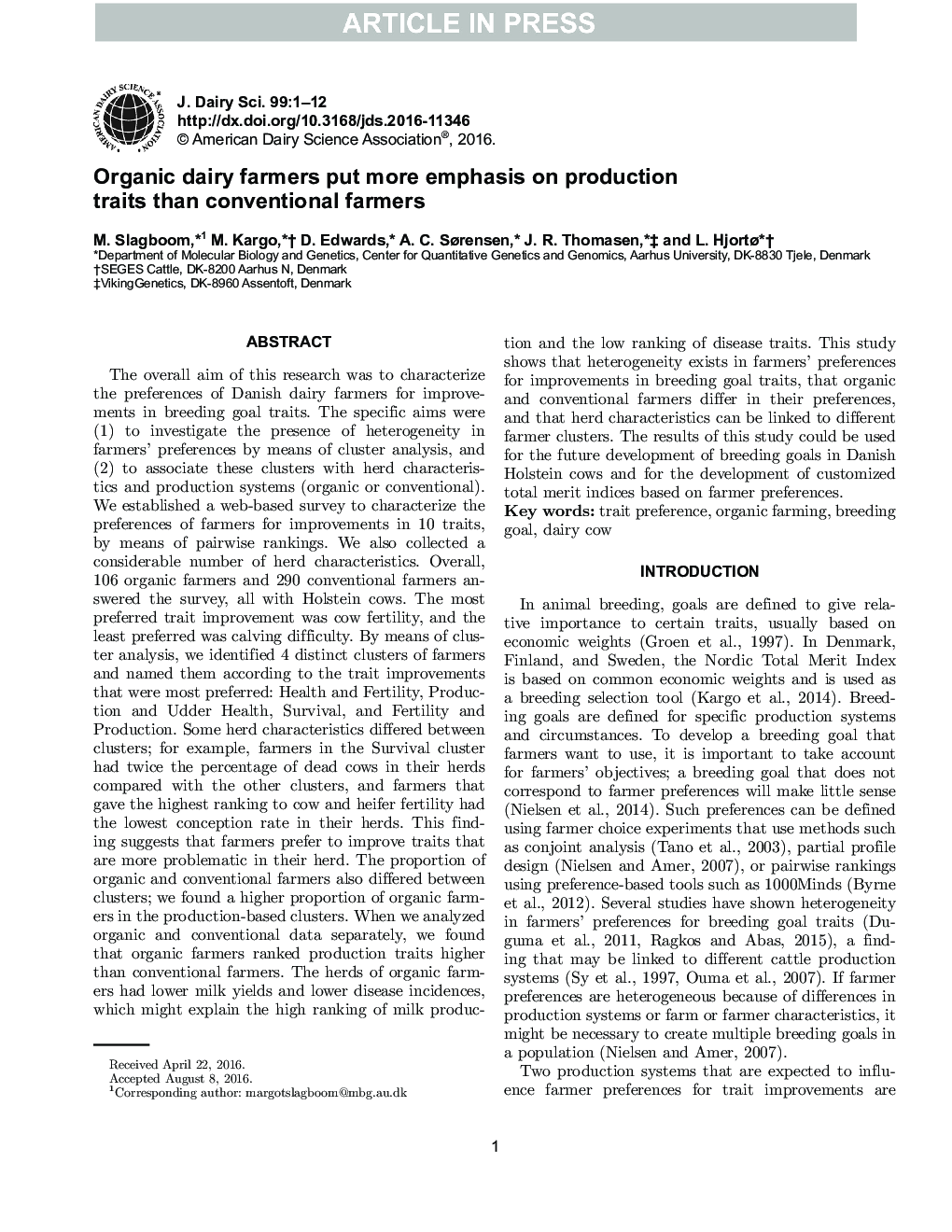| کد مقاله | کد نشریه | سال انتشار | مقاله انگلیسی | نسخه تمام متن |
|---|---|---|---|---|
| 5542755 | 1402522 | 2016 | 12 صفحه PDF | دانلود رایگان |
عنوان انگلیسی مقاله ISI
Organic dairy farmers put more emphasis on production traits than conventional farmers
ترجمه فارسی عنوان
کشاورزان لبنی آلوده بیشتر به صفات تولید نسبت به کشاورزان معمولی تأکید دارند
دانلود مقاله + سفارش ترجمه
دانلود مقاله ISI انگلیسی
رایگان برای ایرانیان
کلمات کلیدی
اولویت صفات، کشاورزی ارگانیک، هدف پرورش، گاو شیری،
ترجمه چکیده
هدف کلی این تحقیق مشخص کردن ترجیحات کشاورزان لبنی دانمارکی برای بهبود ویژگی های هدف پرورش است. اهداف خاص عبارت بودند از: (1) بررسی وجود ناهمگونی در ترجیحات کشاورزان با استفاده از تجزیه خوشه ای و (2) این خوشه ها را با ویژگی های گله و سیستم های تولید (ارگانیک یا متعارف) مرتبط سازید. ما یک بررسی مبتنی بر وب برای مشخص کردن ترجیحات کشاورزان برای بهبود 10 ویژگی، با استفاده از رتبه بندی های زوج ایجاد کردیم. ما همچنین تعداد قابل توجهی از ویژگی های گله را جمع آوری کردیم. به طور کلی، 106 کشاورز ارگانیک و 290 کشاورز معمولی به این تحقیق پاسخ دادند که همه آنها گاوهای هلشتاین است. بیشترین خصوصیات بهبودی، باروری گاو بود و کمترین اهمیت دادن به مشکل زایمان بود. با استفاده از تجزیه و تحلیل خوشه ای، ما 4 خوشه های متمایز از کشاورزان را شناسایی کردیم و آنها را با توجه به پیشرفت هایی که بیشترین ترجیح داده می شدند نام بردیم: سلامت و باروری، تولید و سلامت تخممرغ، بقا و باروری و تولید. برخی از ویژگی های گله بین خوشه ها متفاوت بود؛ برای مثال، کشاورزان در خوشه بقای دو برابر درصد گاوهای مرده در گله های خود را نسبت به خوشه های دیگر، و کشاورزان که بالاترین رتبه را به گاو و باروری تلیسه داده بودند، کمترین میزان تخمک گذاری در گله های آنها بود. این یافته نشان می دهد که کشاورزان ترجیح می دهند که ویژگی هایی را که در گله هایشان مشکل تر است، بهبود بخشد. نسبت کشاورزان ارگ و متعارف نیز بین خوشه ها متفاوت بود؛ ما مقادیر بیشتری از کشاورزان ارگانی را در خوشه های مبتنی بر تولید پیدا کردیم. هنگامی که دادههای ارگانیک و متعارف را به صورت جداگانه تجزیه و تحلیل کردیم، دریافتیم که کشاورزان ارگانیک دارای صفات تولیدی بالاتر از کشاورزان معمولی هستند. گله های کشاورزان ارگانیک دارای مقادیر پایین شیر و بیماری های پایین تر بیماری بودند که ممکن است طبقه بندی بالای تولید شیر و درجه پایین صفات بیماری را توضیح دهد. این مطالعه نشان می دهد که ناهمگونی در ترجیحات کشاورزان برای بهبود ویژگی های هدف پرورش وجود دارد، که کشاورزان ارگ و متعارف در تنظیمات آنها متفاوت هستند و ویژگی های گله را می توان با خوشه های مختلف کشاورزان مرتبط کرد. نتایج این مطالعه می تواند برای توسعه آینده اهداف پرورش در گاوهای هولشتاین دانمارکی و برای توسعه شاخص های شایستگی بر اساس ترجیحات کشاورزان مورد استفاده قرار گیرد.
موضوعات مرتبط
علوم زیستی و بیوفناوری
علوم کشاورزی و بیولوژیک
علوم دامی و جانورشناسی
چکیده انگلیسی
The overall aim of this research was to characterize the preferences of Danish dairy farmers for improvements in breeding goal traits. The specific aims were (1) to investigate the presence of heterogeneity in farmers' preferences by means of cluster analysis, and (2) to associate these clusters with herd characteristics and production systems (organic or conventional). We established a web-based survey to characterize the preferences of farmers for improvements in 10 traits, by means of pairwise rankings. We also collected a considerable number of herd characteristics. Overall, 106 organic farmers and 290 conventional farmers answered the survey, all with Holstein cows. The most preferred trait improvement was cow fertility, and the least preferred was calving difficulty. By means of cluster analysis, we identified 4 distinct clusters of farmers and named them according to the trait improvements that were most preferred: Health and Fertility, Production and Udder Health, Survival, and Fertility and Production. Some herd characteristics differed between clusters; for example, farmers in the Survival cluster had twice the percentage of dead cows in their herds compared with the other clusters, and farmers that gave the highest ranking to cow and heifer fertility had the lowest conception rate in their herds. This finding suggests that farmers prefer to improve traits that are more problematic in their herd. The proportion of organic and conventional farmers also differed between clusters; we found a higher proportion of organic farmers in the production-based clusters. When we analyzed organic and conventional data separately, we found that organic farmers ranked production traits higher than conventional farmers. The herds of organic farmers had lower milk yields and lower disease incidences, which might explain the high ranking of milk production and the low ranking of disease traits. This study shows that heterogeneity exists in farmers' preferences for improvements in breeding goal traits, that organic and conventional farmers differ in their preferences, and that herd characteristics can be linked to different farmer clusters. The results of this study could be used for the future development of breeding goals in Danish Holstein cows and for the development of customized total merit indices based on farmer preferences.
ناشر
Database: Elsevier - ScienceDirect (ساینس دایرکت)
Journal: Journal of Dairy Science - Volume 99, Issue 12, December 2016, Pages 9845-9856
Journal: Journal of Dairy Science - Volume 99, Issue 12, December 2016, Pages 9845-9856
نویسندگان
M. Slagboom, M. Kargo, D. Edwards, A.C. Sørensen, J.R. Thomasen, L. Hjortø,
